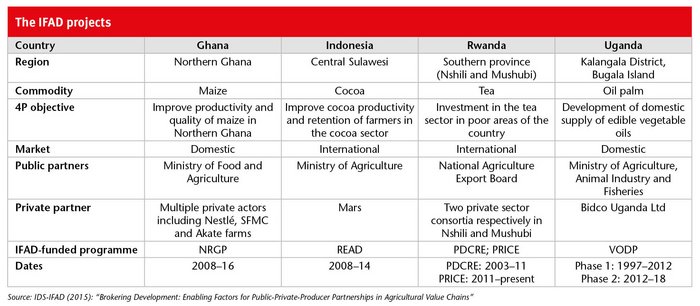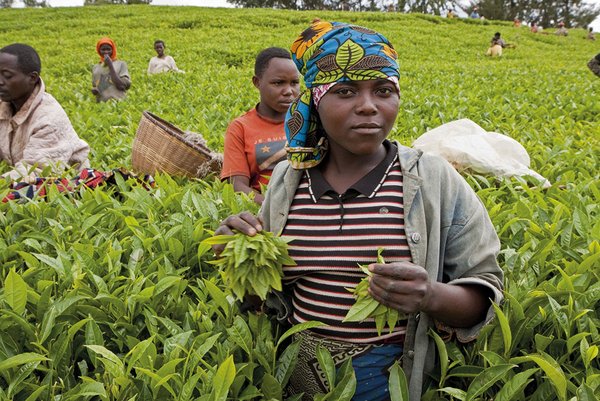 Download this article in magazine layout
Download this article in magazine layout
- Share this article
- Subscribe to our newsletter
The four Ps – a market-led development for smallholders
The 4P approach goes beyond conventional public-private partnership (PPP) as it implies considering smallholders as respected partners and not just suppliers of a private company. In fact, a 4P requires truly win-win cooperation between a government, business agents and small-scale producers to reach a common goal by sharing competencies, resources, risks and benefits. For example, in a typical 4P, while producers commit to producing according to market requirements (in terms of quality and volumes), the private partner agrees to pay a fair and transparent price and sometimes to provide technical support, and the public sector ensures complementary investments in infrastructure or public services.
Success factors
How to set up an effective and successful 4P from a development point of view? An IFAD-commissioned study executed by the Institute of Development Studies (IDS) of the University of Sussex addresses this question. Through the analysis of results and lessons from case studies in Ghana, Indonesia, Rwanda and Uganda (see Box below), IDS was able to identify a number of enabling factors to ensure the development impact of agricultural 4Ps. Below we will refer to some of them.

The first critical factor for the success of a 4P is to correctly define its rationale and underlying assumption at the outset. The key questions at this stage are: “What is the main constraint to overcome?” and “How will working with the private sector overcome this constraint?” Equally important is to be explicit about assumptions being made and why these are justified as part of a theory of change of the 4P considering whether the interests of all actors can be aligned towards a shared vision and they have incentives to contribute to the long-term success of the 4P. The case study in Indonesia shows how different perceptions between the public and the private sector not fully addressed at the 4P initial stage led to different expectations about the reciprocal role in the provision of technical assistance and extension services to target cocoa farmers. The IFAD-funded project partnered with Mars, a major cocoa buyer world-wide and in the region, to establish Cocoa Development Centres (CDCs) and Village Cocoa Centres (VCCs) for training on improved cocoa management techniques based on a model piloted by the company in South Sulawesi. Mars provided the technology package and gave the initial training which was replicated by the project for a number of lead farmers and public extension officers. Unfortunately, extension agents lacked incentives to specialise in cocoa, while the level of training provided was not sufficient to transform farmers into extension agents. As a result, demand for services of Mars agents remained too high for their actual delivery capacity. Ultimately, this resulted in less than optimal results.
Ensuring a clear market pull is the second success factor. This represents a fundamental paradigm shift compared with agricultural development interventions in the ‘80s and ‘90s, where the focus was mainly on productivity and production increase. Adopting a value chain approach ensures a comprehensive understanding of market opportunities for smallholders as well as the identification of potential partners at different stages of the chain (inputs provision, post-harvest handling, processing, distribution, etc.). In some cases, the 4P business model promoted is a vertical integration between producers and the lead firm. This was, for example, the case with the Uganda palm oil processing company or the Rwanda tea leaves processing factories. In vertically co-ordinated models, companies exert significant control on supply. This allows them to enforce quality standards and drive efficiency while offering farmers secure markets and, sometimes, funding to meet production targets. Other models are based on more flexible business relationships such as the case of Ghana grains buyers and aggregators. These so-called relationship-based models put emphasis on trust building, involve multiple private sector actors and provide farmers with the flexibility to change crop composition within the system.
Prioritising farmer ownership of the 4P and involvement of all partners is key. For a 4P to be successful, all partners, including smallholders, need to have a strong buy-in and understanding of roles and responsibilities that reflect priorities and interests. To do so, it is vital to involve farmers both in the design of the 4P, checking with them the viability of critical assumptions, projections and expectations which otherwise may risk to be proven wrong, as well as in the 4P governance structure. The poor maintenance of plots in Rwanda, which resulted in yields significantly below the assumptions made at the 4P design stage without consulting farmers, or side-selling of fertiliser in Uganda and maize in Ghana can be seen as indicative of weak farmer commitment and ownership alongside short-term economic pressure. Despite laudable efforts to build ownership by providing farmers with equity shares in the processing factories in Rwanda or by strengthening their voice in the governance structure in Uganda, these problems still arose.
Aligning incentives and building trust among partners to make them confident to play the expected role in the partnership requires time and efforts, particularly in certain contexts where actors adopt opportunistic behaviours and purely price maximisation strategies. To this end, IFAD has acted as a broker in the Uganda and Indonesia cases, where it was facilitating discussions, negotiations and planning between the private sector partners and the government. In Indonesia, both the government and the private sector partner (Mars) had reservations about working together respectively because of limited experience in PPPs in the agriculture sector and of concerns about bureaucracy. Therefore, IFAD, acting as a neutral broker, worked with both parties and helped them identify common objectives for the 4Ps, build trust and align their interests. Alternatively, in Ghana this brokerage role has been outsourced to an external actor (a supporting NGO) that helped coordinate actors in the value chain and provided training to farmers. A similar arrangement is currently adopted in an IFAD-funded 4P brokerage initiative executed by SNV Netherlands Development Cooperation in five pilot countries (El Salvador, Mozambique, Senegal, Uganda and Vietnam).
Managing risks is simply essential in a business such as agriculture. Unless these risks are properly identified, shared and managed, farmers, i.e. the weakest actor in the value chain, tend to bear a disproportionate share, and this can ultimately undermine their livelihood and the sustainability of the whole 4P arrangement. In the Uganda case, risks related to farmers’ ability to repay loans have been partly mitigated by linking their repayments to yields. Conversely, the Rwanda case was built on the assumption that short-term productivity gains would allow for farmers to serve their loan after three years. Predicted yields proved to be unrealistic and raised doubts over farmers’ loan repayment capacity. Similar concerns were identified in Ghana where farmers were required to repay loans even in years when production was low or the aggregator failed to purchase their produce.
Building the capacity to respond to changes in complex market systems. Agricultural markets consist of many interdependent parts which are determining the dynamics of the system, leading to foreseen and unforeseen outcomes. That is why it is important to establish mechanisms and indicators to monitor the performance of the 4P as well as spaces for communication and negotiation among partners to identify solutions and adapt to the unexpected circumstances. As a matter of fact, in all four case studies, regular meetings were held between representatives of farmers’ co-operatives and the private sector to discuss issues (both internal and external) affecting the functioning of their 4P: e.g. productivity trends, inputs availability and cost, market price variations and transportation.
In conclusion
It is important to acknowledge that the four cases analysed by IDS were not designed from the outset as full-fledge 4Ps, which explains why not all the key enabling factors were always present. In fact, learning from what has not worked completely well has been extremely important in order to identify a set of principles and good practices and feedback to the design of future partnerships adopting a more complete 4P approach. This will hopefully translate into 4Ps with even greater development impact on the lives of the rural poor.
Key learnings ….
… from Indonesia
• Clear objectives. The 4P had a very clear objective of increasing the productivity and quality of cocoa produced by smallholder farmers. This clarity allowed IFAD to play a key role in identifying a private sector partner with a shared interest and strong technical competency. However, assumptions around how much training would be sufficient led to unfulfilled expectations among the partners.
• Develop incentives for the stakeholders to continue in their new roles. The longterm sustainability of CDCs and VCCs depends on the willingness and ability of stakeholders to carry on new functions. However, extension agents in particular lack incentives to specialise in cocoa, undermining such sustainability.
… from Rwanda
• Promoting shared interests. The 4P were designed to incentivise partners to work together and thus to achieve shared success. The tea factory, which was the private sector partner, needed to secure supplies from the cooperative bloc and the farmers to be profitable. However, unless the cooperatives can significantly increase productivity at each site, for which they need the support of the private sector and the public sector, the viability of the entire 4P will be at stake.
• Consulting smallholder producers. Despite the efforts to build farmer ownership of the 4P by providing them with equity shares in the processing factories, the poor maintenance of plots and low farmer involvement suggests that the 4P arrangements do not sufficiently take into account farmers’ needs and capacities. Challenges around production constraints or alternative income sources in the early years could have been addressed through stronger involvement of farmers in 4P planning.
… from Ghana
• Innovative governance mechanisms. The District Value Chain Committee (DVCC) created by the project promoted trust and the sharing of information between value chain actors, facilitated by an external broker (a local NGO called ACDEP). It provided a space to share and access transparent information around input or service prices and supported the ‘cashless credit system’, giving rural banks greater confidence in working with farmers.
• Risk management. It is vital to identify and quantify the risks facing each stakeholder in 4P arrangements, so that mechanisms for appropriate sharing of risks can be developed. The high exposure to risk on the part of farmers and rural banks in Ghana has threatened programme sustainability.
… from Uganda
• Flexibility to respond to changing circumstances. It is inevitable that in complex and large-scale developments involving numerous partners with different motivations and interests, unanticipated challenges will arise. Good monitoring fostered by IFAD and the Kalangala Oil Palm Growers Trust (KOPGT) has enabled the 4P to continue to move forward, with good communication and negotiation towards joint solutions or adaptations.
• Farmers’ sense of ownership. While KOPGT has played a central role in implementing the 4P, the lines of accountability between it and participating smallholder farmers are unclear. The fact that farmers set up the Kalangala Oil Palm Growers Association (KOPGA) to represent their interests a year after KOPGT’s inception illustrates the lack of ownership they felt within the Trust.
Source: IDS-IFAD (2015): “Brokering Development: Enabling Factors for Public-Private-Producer Partnerships in Agricultural Value Chains”
Marco Camagni & Christa Ketting
Rural Markets & Enterprises Team
Policy and Technical Advisory Division
International Fund for Agricultural Development (IFAD)
Rome, Italy
m.camagni@ifad.org
c.ketting@ifad.org





Add a comment
Be the First to Comment